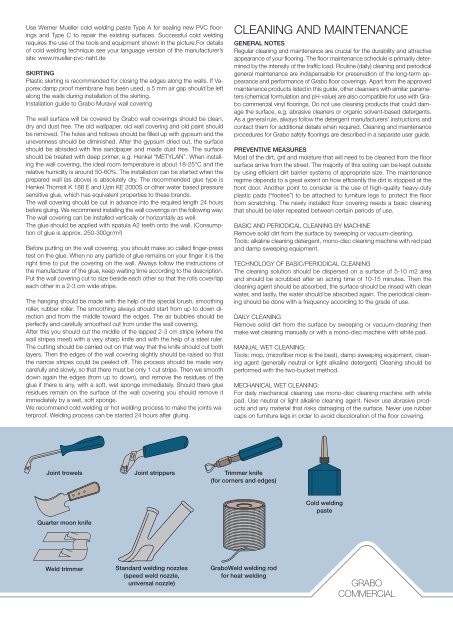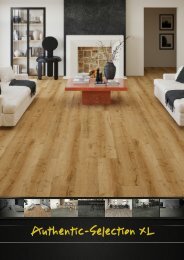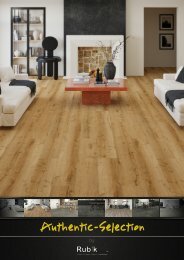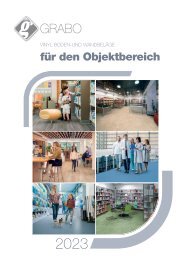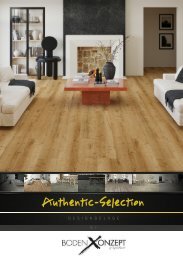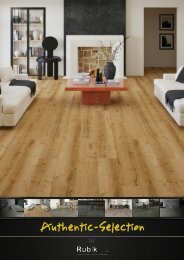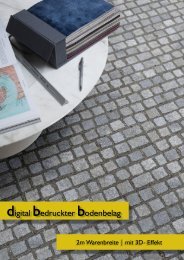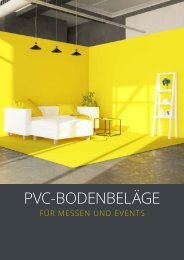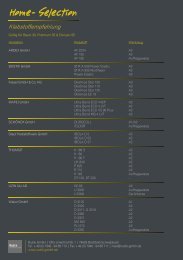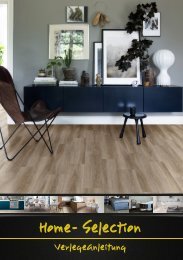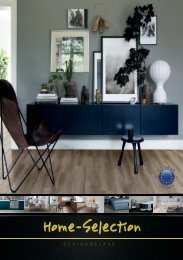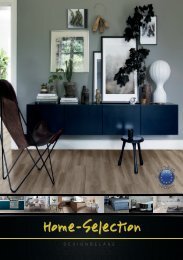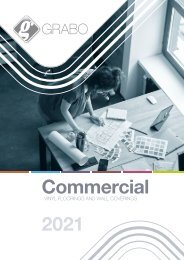Commercial 2018
Create successful ePaper yourself
Turn your PDF publications into a flip-book with our unique Google optimized e-Paper software.
Use Werner Mueller cold welding paste Type A for sealing new PVC floorings<br />
and Type C to repair the existing surfaces. Successful cold welding<br />
requires the use of the tools and equipment shown in the picture.For details<br />
of cold welding technique see your language version of the manufacturer’s<br />
site: www.mueller-pvc-naht.de<br />
SKIRTING<br />
Plastic skirting is recommended for closing the edges along the walls. If Vaporex<br />
damp proof membrane has been used, a 5 mm air gap should be left<br />
along the walls during installation of the skirting.<br />
Installation guide to Grabo Muravyl wall covering<br />
The wall surface will be covered by Grabo wall coverings should be clean,<br />
dry and dust free. The old wallpaper, old wall covering and old paint should<br />
be removed. The holes and hollows should be filled up with gypsum and the<br />
unevenness should be diminished. After the gypsum dried out, the surface<br />
should be abraded with fine sandpaper and made dust free. The surface<br />
should be treated with deep primer, e.g. Henkel “METYLAN”. When installing<br />
the wall covering, the ideal room temperature is about 18-25°C and the<br />
relative humidity is around 50-60%. The installation can be started when the<br />
prepared wall (as above) is absolutely dry. The recommended glue type is<br />
Henkel Thomsit K 188 E and Uzin KE 2000S or other water based pressure<br />
sensitive glue, which has equivalent properties to these brands.<br />
The wall covering should be cut in advance into the required length 24 hours<br />
before gluing. We recommend installing the wall coverings on the following way:<br />
The wall covering can be installed vertically or horizontally as well.<br />
The glue should be applied with spatula A2 teeth onto the wall. (Consumption<br />
of glue is approx. 250-300gr/m²)<br />
Before putting on the wall covering, you should make so called finger-press<br />
test on the glue. When no any particle of glue remains on your finger it is the<br />
right time to put the covering on the wall. Always follow the instructions of<br />
the manufacturer of the glue, keep waiting time according to the description.<br />
Put the wall covering cut to size beside each other so that the rolls cover/lap<br />
each other in a 2-3 cm wide stripe.<br />
The hanging should be made with the help of the special brush, smoothing<br />
roller, rubber roller. The smoothing always should start from up to down direction<br />
and from the middle toward the edges. The air bubbles should be<br />
perfectly and carefully smoothed out from under the wall covering.<br />
After this you should cut the middle of the lapped 2-3 cm stripe (where the<br />
wall stripes meet) with a very sharp knife and with the help of a steel ruler.<br />
The cutting should be carried out on that way that the knife should cut both<br />
layers. Then the edges of the wall covering slightly should be raised so that<br />
the narrow stripes could be peeled off. This process should be made very<br />
carefully and slowly, so that there must be only 1 cut stripe. Then we smooth<br />
down again the edges (from up to down), and remove the residues of the<br />
glue if there is any, with a soft, wet sponge immediately. Should there glue<br />
residues remain on the surface of the wall covering you should remove it<br />
immediately by a wet, soft sponge.<br />
We recommend cold welding or hot welding process to make the joints waterproof.<br />
Welding process can be started 24 hours after gluing.<br />
CLEANING AND MAINTENANCE<br />
GENERAL NOTES<br />
Regular cleaning and maintenance are crucial for the durability and attractive<br />
appearance of your flooring. The floor maintenance schedule is primarily determined<br />
by the intensity of the traffic load. Routine (daily) cleaning and periodical<br />
general maintenance are indispensable for preservation of the long-term appearance<br />
and performance of Grabo floor coverings. Apart from the approved<br />
maintenance products listed in this guide, other cleansers with similar parameters<br />
(chemical formulation and pH-value) are also compatible for use with Grabo<br />
commercial vinyl floorings. Do not use cleaning products that could damage<br />
the surface, e.g. abrasive cleaners or organic solvent-based detergents.<br />
As a general rule, always follow the detergent manufacturers’ instructions and<br />
contact them for additional details when required. Cleaning and maintenance<br />
procedures for Grabo safety floorings are described in a separate user guide.<br />
PREVENTIVE MEASURES<br />
Most of the dirt, grit and moisture that will need to be cleaned from the floor<br />
surface arrive from the street. The majority of this soiling can be kept outside<br />
by using efficient dirt barrier systems of appropriate size. The maintenance<br />
regime depends to a great extent on how efficiently the dirt is stopped at the<br />
front door. Another point to consider is the use of high-quality heavy-duty<br />
plastic pads (“footies”) to be attached to furniture legs to protect the floor<br />
from scratching. The newly installed floor covering needs a basic cleaning<br />
that should be later repeated between certain periods of use.<br />
BASIC AND PERIODICAL CLEANING BY MACHINE<br />
Remove solid dirt from the surface by sweeping or vacuum-cleaning.<br />
Tools: alkaline cleaning detergent, mono-disc cleaning machine with red pad<br />
and damp sweeping equipment.<br />
TECHNOLOGY OF BASIC/PERIODICAL CLEANING<br />
The cleaning solution should be dispersed on a surface of 5-10 m2 area<br />
and should be scrubbed after an acting time of 10-15 minutes. Then the<br />
cleaning agent should be absorbed, the surface should be rinsed with clean<br />
water, and lastly, the water should be absorbed again. The periodical cleaning<br />
should be done with a frequency according to the grade of use.<br />
DAILY CLEANING<br />
Remove solid dirt from the surface by sweeping or vacuum-cleaning then<br />
make wet cleaning manually or with a mono-disc machine with white pad.<br />
MANUAL WET CLEANING:<br />
Tools: mop, (microfiber mop is the best), damp sweeping equipment, cleaning<br />
agent (generally neutral or light alkaline detergent) Cleaning should be<br />
performed with the two-bucket method.<br />
MECHANICAL WET CLEANING:<br />
For daily mechanical cleaning use mono-disc cleaning machine with white<br />
pad. Use neutral or light alkaline cleaning agent. Never use abrasive products<br />
and any material that risks damaging of the surface. Never use rubber<br />
caps on furniture legs in order to avoid discoloration of the floor covering.<br />
Joint trowels Joint strippers Trimmer knife<br />
(for corners and edges)<br />
Cold welding<br />
paste<br />
Quarter moon knife<br />
Weld trimmer<br />
Standard welding nozzles<br />
(speed weld nozzle,<br />
universal nozzle)<br />
GraboWeld welding rod<br />
for heat welding<br />
GRABO<br />
COMMERCIAL


